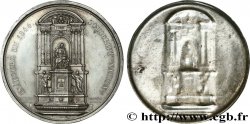fme_962263 - LOUIS-PHILIPPE I Médaille, Louis Marie de Cormenin
65.00 €(Approx. 66.95$ | 54.60£)
Quantity
Add to your cart

Type : Médaille, Louis Marie de Cormenin
Date: 1842
Metal : copper
Diameter : 50,5 mm
Orientation dies : 12 h.
Engraver ROGAT Émile (1770-1852)
Weight : 70,87 g.
Edge : lisse + proue CUIVRE
Puncheon : Proue (1842 - 1845)
Coments on the condition:
Jolie patine marron hétérogène, présentant quelques marques d’usure sur les hauts reliefs de l’avers. Quelques coups sur les bords de la tranche
Obverse
Obverse legend : LOUIS MARIE - DE CORMENIN.
Obverse description : Buste à gauche de Louis Marie de Cormenin, signé : E. ROGEAT 1842.
Reverse
Reverse legend : ANÉPIGRAPHE.
Reverse description : Statue d'un ange entourée d'un grand nombre de statues d'hommes célèbres ; derrière, le Panthéon ; dans le champ, signature E ROGAT..
Commentary
Louis Marie de Lahaye, baron (1818) puis vicomte (1826) de Cormenin, est un jurisconsulte, publiciste et homme politique français, né à Paris le 6 janvier 1788 et mort dans la même ville le 6 mai 1868.
Issu d'une ancienne famille de robe de la Bresse établie dans l'Orléanais depuis trois générations, Cormenin eut pour parrain et marraine le duc de Penthièvre et la princesse de Lamballe. Ses liens familiaux avec Versailles étaient multiples : son père avait été lieutenant général de l'Amirauté, et du côté de sa mère, Victoire Henriette Foacier, il descendait d'un frère du compositeur Delalande, de l'intendant général des Armées navales françaises et célèbre numismate Joseph Pellerin. Il était également le petit-fils du ministre Arnaud de Laporte, proche collaborateur de Louis XVI, mort sur l'échafaud révolutionnaire.
Il fit ses études dans un pensionnat de Paris puis à l'école de droit et fut reçu avocat en 1808. Il écrivit des vers dans le Mercure de France et l’Almanach des muses sous le Premier Empire. En janvier 1810, il fut nommé auditeur au Conseil d'État (section du contentieux). Il accompagna Cochon de Lapparent dans sa mission à la 20e division militaire (1813). Nommé maître des requêtes surnuméraire en 1814, il s'engagea à Lille comme volontaire pendant les Cent-Jours..
Issu d'une ancienne famille de robe de la Bresse établie dans l'Orléanais depuis trois générations, Cormenin eut pour parrain et marraine le duc de Penthièvre et la princesse de Lamballe. Ses liens familiaux avec Versailles étaient multiples : son père avait été lieutenant général de l'Amirauté, et du côté de sa mère, Victoire Henriette Foacier, il descendait d'un frère du compositeur Delalande, de l'intendant général des Armées navales françaises et célèbre numismate Joseph Pellerin. Il était également le petit-fils du ministre Arnaud de Laporte, proche collaborateur de Louis XVI, mort sur l'échafaud révolutionnaire.
Il fit ses études dans un pensionnat de Paris puis à l'école de droit et fut reçu avocat en 1808. Il écrivit des vers dans le Mercure de France et l’Almanach des muses sous le Premier Empire. En janvier 1810, il fut nommé auditeur au Conseil d'État (section du contentieux). Il accompagna Cochon de Lapparent dans sa mission à la 20e division militaire (1813). Nommé maître des requêtes surnuméraire en 1814, il s'engagea à Lille comme volontaire pendant les Cent-Jours..








 Report a mistake
Report a mistake Print the page
Print the page Share my selection
Share my selection Ask a question
Ask a question Consign / sell
Consign / sell
 Full data
Full data









